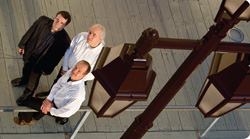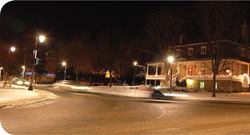From left, clockwise: Guy Carignan, John-Pierre Desrochers, and …
Streetlight Development Manager Guy Carignan and his team of five technicians program and maintain the city’s arterial traffic network, which includes 750 intersections. They’re also responsible for reducing energy use, which led to their looking into a managed street-lighting system.
When the city decided to replace all streetlights in an historical district, Carignan took the opportunity to try a managed system for the 200 new fixtures. He and his team quickly found themselves facing significant challenges. It was 2005. Because initial installations had been done only in Europe, neither electronic ballasts nor power line communication equipment were available in North American voltages.
After finding a source of reliable electronic ballasts in Metrolight of Franklin, Tenn., Carignan ordered the new fixtures without ballasts. Meanwhile, with assistance from Echelon, Carignan and his team built their own power line communication devices to communicate through an i.Lon server controlling each segment, and connected it to the office computer system.
A subsequent installation, begun in June, includes upgrading another set of streetlights to a managed system. The city converted to energy-efficient high-pressure sodium (HPS) lamps years ago, so this upgrade includes only changing the ballasts and installing communications transceivers. By the end of the year, Carignan’s team will have 400 streetlights on the managed system and plans to convert another 400 early next year.
Power line meters provide the team with energy use data, including current, voltage, and frequency of the lines. But the benefits extend far beyond just reducing electrical consumption:
Simplified inventory. By using the dimming capability of the new ballasts, the city was able to use 100 W lamps for all new fixtures in the historical installation while still providing different levels of illumination.
The fixtures are grouped into three segments, with one set at full power, another at 70 W, and the third at 50 W. They’re turned on by standard photocell sensors as daylight fades. The lamps operating at 100 W and 70 W provide extra illumination during the evening; for example, to highlight the historic structures.
After midnight, when peak viewing hours have passed, the control system automatically dims them to 50 W until the photocell sensors turn off all the lights as daylight returns.
Distributed control. Carignan says another useful feature is the ability to assign control of individual fixtures to another government entity.
For example, the police department might be assigned control of certain strategically placed fixtures, which it could brighten as needed. Also, park personnel might be given local control to dim one or more lights during special events such as fireworks.








